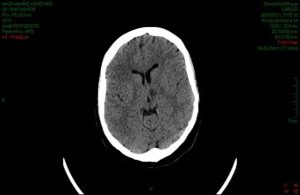8 Case Analysis 3: Ms. Armour’s Aching Head
Learning Objectives
Process Learning Objectives:
Through authentic practice and shared inquiry in this case, students will develop:
- Information literacy skills, including the ability to locate, access, evaluate and use information in a wide range of situations.
- Awareness of the role of emotions in learning.
- Self-directed learning and metacognitive strategies to maximize their learning effectiveness.
- Fluency in reading, writing, summarizing, speaking, listening, viewing and presenting information.
- Social skills critical to effective team functioning, including interacting, cooperating, collaborating, and mutual respect for others’ ideas.
Content Learning Objectives:
Through authentic practice and shared inquiry in this case, students will develop a deep understanding of cerebrovascular accidents (CVA, stroke) including:
- Etiology, symptoms and causes of cerebrovascular accidents (CVA, stroke)
- Diagnosis and classification of cerebrovascular accidents (CVA, stroke)
- Differentiation of hemorrhagic stroke from ischemic stroke
- Effects of pregnancy on hypercoagulability
- Diagnostic features of hemorrhagic and ischemic stroke on head CT
- Management and treatment of hemorrhagic and ischemic stroke
- Prevention of hemorrhagic and ischemic stroke
- Outlook/Prognosis for those following cerebrovascular accidents (CVA, stroke)
The Case of Ms. Armour’s Aching Head
History and Assessment
|
Past Medical History
|
|
Family History Ms. Armour is married, and lives with her husband and 5 children, who are ages 16, 10, 6, 4 and 8 days. She is not taking any medications. She is an ex-smoker with an eight pack year history.
|
Immediate Assessment
- BP 156/98 mmHg
- Pulse 108/min
- Respiratory rate 23/min
- BMI 33 kg/m2
The nurse asks Ms. Armour if she has any blurred vision, has had any floaters, nausea or vomiting.
Ms. Armour reports that she has had nausea for 24 hours and has vomited 3 times. She has had some blurred vision with floaters. She reports that these symptoms are common with her migraines.
The nurse asks if she has had any sudden weight gain or swelling in the hands, feet or face.
Ms. Armour reports that her hands are swollen and she had to take off her rings.
Stop here!
Identify important observations and generate hypotheses based on your observations. Using numbers or arrows (or some other system), link each hypothesis to the observation(s) which support that hypothesis. What assessments/interventions should occur next in Ms. Armour’s care?
Begin your list of learning issues.
Lab Results
| Result | |
| Hematology Profile:
Leukocyte count (WBC) |
9.3 x109/L |
| Erythrocyte sedimentation rate | 47 mm/hr |
| Hemoglobin | 11.7 g/dL |
| Hematocrit | 42% |
| Platelet | 288 x109/L |
| C-reactive protein (CRP) | 20 mg/L |
| TSH | 2.0 mIU/L |
| Coagulation Panel:
PT |
14 s |
| PTT | 30 s |
| Chemistries:
Creatinine |
1.2 g/dl |
| BUN | 20 g/dl |
As she is drawing blood, the nurse notes that some of Ms. Armour’s responses seem confused, as she was talking about a “flying giraffe” and seemed somewhat drowsy.
Dr. Evans conducts a further neurological assessment, and finds failure of upwards gaze and internuclear opthalmoplegia. Some vertical nystagmus was noted. Power, tone, sensation and reflexes were all normal. Plantars were down-going bilaterally. There was not fine tremor.
Dr. Evans admits Ms. Armour and orders a CT of the head.
Stop here!
Identify important observations and generate hypotheses based on your observations. Using numbers or arrows (or some other system), link each hypothesis to the observation(s) which support that hypothesis. What assessments/interventions should occur next in Ms. Armour’s care?
Add to your list of learning issues.

Radiology Report
Examination: CT of the Head without contrast
History: Headache, confusion and drowsiness
Findings: A CT of the Head without contrast was obtained. An area of low attenuation is identified within the left thalamus extending toward the midline and close to the third ventricle.
Impression: Acute infarct
Stop here!
Identify important observations and generate hypotheses based on your observations. Using numbers or arrows (or some other system), link each hypothesis to the observation(s) which support that hypothesis. What assessments/interventions should occur next in Ms. Armour’s care?
Add to your list of learning issues.

Radiology Report
Examination: MRI of the brain
History: Acute infarct on CT
Findings: An MRI of the brain was obtained. High signal changes in the left thalamus on T2-weighted and fluid attenuated inversion recovery (FLAIR) axial images are noted. The region demonstrates restricted diffusion on diffusion-weighted imaging (DWI) and low calculated apparent diffusion coefficients (ADC). The cerebral venous sinuses are patent.
Impression: Acute infarct
Media Attributions
- CT Head
- MR Head

